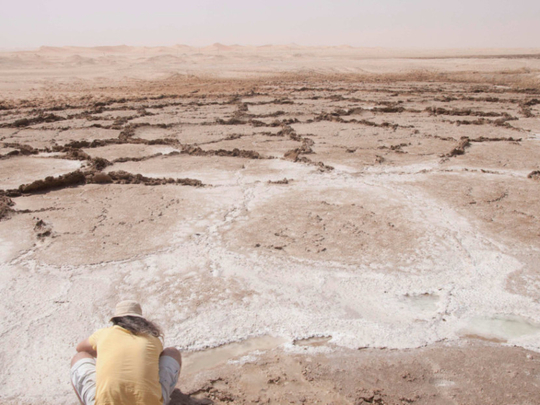
Abu Dhabi: Many people may not be aware of Abu Dhabi’s coastal sabkhas — the Arabic phonetic translation for salt flats — but the distinctive coastal areas hold several benefits in store, making their preservation and protection all the more important.
Sabkha sites hold great potential for solar power generation and algae culture, also holding out promise in terms of hydrocarbons.
However, many sabkha sites are facing threats from rapid urbanisation and construction projects.
Abu Dhabi’s coastal sabkhas include channels, inlets, islands, shoals and is as wide as 16 kilometres at some points, experts say.
Dr Fares M. Howari, Professor at the College of Sustainability and Humanities, Zayed University, has conducted several studies on the sabkhas and also made them a subject for a film documentary, which will be aired on the National Geographic Channel in the UAE.
Speaking to Gulf News, Dr Howari touched on the many benefits of sabkhas. “Sabkha is a flat area with a high concentration of salts and sediments. The level of groundwater in the sabkha is very low and in some locations it is zero. Sabkhas can be found in coastal areas or inland areas. Sabkhas are located in supratidal zones, forming along arid coastlines and are characterised by evaporate-carbonate deposits.”
Sabkhas are being affected adversely by construction, he added, while observing that sabkhas themselves pose challenges for construction, such as corrosion. Sabkhas can also have an adverse effect on agricultural areas.
“Urbanisation and land development affect the sabkhas. We should also know that the expansion of sabkhas is something that is ideal, especially if the sabkha or the sabkha-like conditions influence agricultural areas and constructions sites. The salt could kill plant and vegetation cover and could cause corrosion problems in construction sites. It is noteworthy to mention that mangrove trees are the only species that can tolerate the harsh conditions of the sabkha’s environment.”
The sabkhas do hold out many benefits though, the professor added.
“Sabkhas have algal mat. Algal mat is a layer of usually filamentous algae found in shallow water in coastal environments or fresh water. It may be considered one of many types of microbial mats. The dark mat is rich with hydrocarbon; it can be considered as a source of hydrocarbon that is not yet mature to yield oil but it can do so after thermal treatment.”
Producing clean electricity is another possibility as well, Dr Howari said.
“In some areas of the sabkas areas, there are lagoons or small lakes. Water is stratified or forms three layers. The very salty water is heavy and located at the bottom of the lake. This layer stores solar energy and, as a result, its temperature could reach 80 degrees or so. A technology has been developed to extract the heat and use it to produce electricity,” he said.
The sabkhas can also be a good source of mineral deposits that could prove very useful for pharmaceutical and chemical industries, he said. “Yes, sabkha has many minerals such as gypsum and halite [table salt]. We can use those minerals directly or process them to get chemicals out of them. Also we can extract other minerals that can be used in pharmaceutical and chemical industries, like potassium salts.”
On how best to preserve the sabkhas, he proposed a number of different solutions including educating thrill-seeking drivers unaware of the importance of such ecosystems. “Sometimes people drive there [on sabkhas] as a part of challenge or as an adventure, and they do not know the importance of those [sites]. Reclaiming the sabkha for construction is something that can be avoided. Some Sabkhas were declared in Abu Dhabi as environmental and cultural heritage sites, and it will be great if more locations make it to the protected list.”












